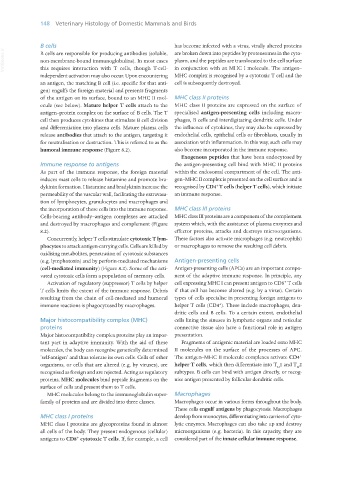Page 166 - Veterinary Histology of Domestic Mammals and Birds, 5th Edition
P. 166
148 Veterinary Histology of Domestic Mammals and Birds
B cells has become infected with a virus, virally altered proteins
VetBooks.ir B cells are responsible for producing antibodies (soluble, are broken down into peptides by proteosomes in the cyto-
non-membrane-bound immunoglobulins). In most cases plasm, and the peptides are translocated to the cell surface
this requires interaction with T cells, though T-cell-
in conjunction with an MHC I molecule. The antigen–
independent activation may also occur. Upon encountering MHC complex is recognised by a cytotoxic T cell and the
an antigen, the matching B cell (i.e. specific for that anti- cell is subsequently destroyed.
gen) engulfs the foreign material and presents fragments
of the antigen on its surface, bound to an MHC II mol- MHC class II proteins
ecule (see below). Mature helper T cells attach to the MHC class II proteins are expressed on the surface of
antigen–protein complex on the surface of B cells. The T specialised antigen-presenting cells including macro-
cell then produces cytokines that stimulate B cell division phages, B cells and interdigitating dendritic cells. Under
and differentiation into plasma cells. Mature plasma cells the influence of cytokines, they may also be expressed by
release antibodies that attach to the antigen, targeting it endothelial cells, epithelial cells or fibroblasts, usually in
for neutralisation or destruction. This is referred to as the association with inflammation. In this way, such cells may
humoral immune response (Figure 8.2). also become incorporated in the immune response.
Exogenous peptides that have been endocytosed by
Immune response to antigens the antigen-presenting cell bind with MHC II proteins
As part of the immune response, the foreign material within the endosomal compartment of the cell. The anti-
induces mast cells to release histamine and promote bra- gen–MHC II complex is presented on the cell surface and is
+
dykinin formation. Histamine and bradykinin increase the recognised by CD4 T cells (helper T cells), which initiate
permeability of the vascular wall, facilitating the extravasa- an immune response.
tion of lymphocytes, granulocytes and macrophages and
the incorporation of these cells into the immune response. MHC class III proteins
Cells-bearing antibody–antigen complexes are attacked MHC class III proteins are a component of the complement
and destroyed by macrophages and complement (Figure system which, with the assistance of plasma enzymes and
8.2). effector proteins, attacks and destroys microorganisms.
Concurrently, helper T cells stimulate cytotoxic T lym- These factors also activate microphages (e.g. neutrophils)
phocytes to attack antigen-carrying cells. Cells are killed by or macrophages to remove the resulting cell debris.
oxidising metabolites, penetration of cytotoxic substances
(e.g. lymphotoxin) and by perforin-mediated mechanisms Antigen-presenting cells
(cell-mediated immunity) (Figure 8.2). Some of the acti- Antigen-presenting cells (APCs) are an important compo-
vated cytotoxic cells form a population of memory cells. nent of the adaptive immune response. In principle, any
Activation of regulatory (suppressor) T cells by helper cell expressing MHC I can present antigen to CD8 T cells
+
T cells limits the extent of the immune response. Debris if that cell has become altered (e.g. by a virus). Certain
resulting from the chain of cell-mediated and humoral types of cells specialise in presenting foreign antigens to
+
immune reactions is phagocytosed by macrophages. helper T cells (CD4 ). These include macrophages, den-
dritic cells and B cells. To a certain extent, endothelial
Major histocompatibility complex (MHC) cells lining the sinuses in lymphatic organs and reticular
proteins connective tissue also have a functional role in antigen
Major histocompatibility complex proteins play an impor- presentation.
tant part in adaptive immunity. With the aid of these Fragments of antigenic material are loaded onto MHC
molecules, the body can recognise genetically determined II molecules on the surface of the processes of APC.
+
‘self-antigen’ and thus tolerate its own cells. Cells of other The antigen–MHC II molecule complexes activate CD4
organisms, or cells that are altered (e.g. by viruses), are helper T cells, which then differentiate into T 1 and T 2
H H
recognised as foreign and are rejected. Acting as regulatory subtypes. B cells can bind with antigen directly, or recog-
proteins, MHC molecules bind peptide fragments on the nise antigen presented by follicular dendritic cells.
surface of cells and present them to T cells.
MHC molecules belong to the immunoglobulin super- Macrophages
family of proteins and are divided into three classes. Macrophages occur in various forms throughout the body.
These cells engulf antigens by phagocytosis. Macrophages
MHC class I proteins develop from monocytes, differentiating into carriers of cyto-
MHC class I proteins are glycoproteins found in almost lytic enzymes. Macrophages can also take up and destroy
all cells of the body. They present endogenous (cellular) microorganisms (e.g. bacteria). In this capacity, they are
antigens to CD8 cytotoxic T cells. If, for example, a cell considered part of the innate cellular immune response.
+
Vet Histology.indb 148 16/07/2019 14:59

